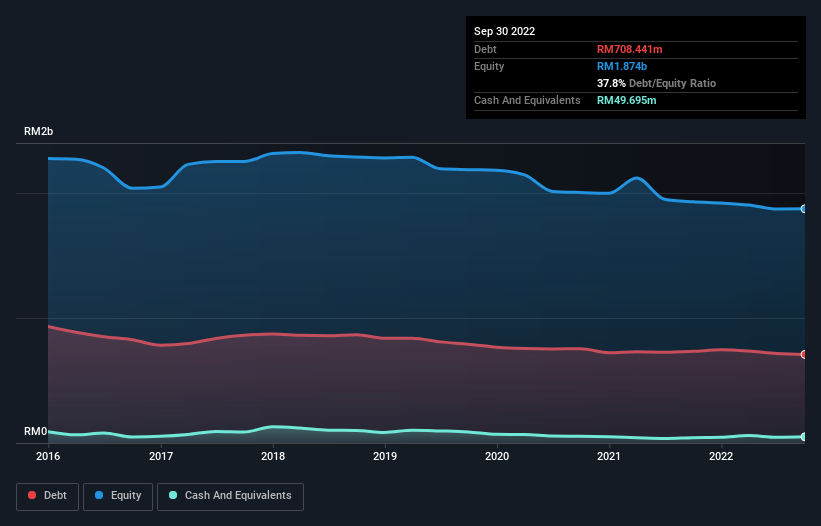- Malaysia
- /
- Hospitality
- /
- KLSE:BJASSET
These 4 Measures Indicate That Berjaya Assets Berhad (KLSE:BJASSET) Is Using Debt Extensively
Some say volatility, rather than debt, is the best way to think about risk as an investor, but Warren Buffett famously said that 'Volatility is far from synonymous with risk.' So it might be obvious that you need to consider debt, when you think about how risky any given stock is, because too much debt can sink a company. Importantly, Berjaya Assets Berhad (KLSE:BJASSET) does carry debt. But the real question is whether this debt is making the company risky.
When Is Debt A Problem?
Debt and other liabilities become risky for a business when it cannot easily fulfill those obligations, either with free cash flow or by raising capital at an attractive price. Ultimately, if the company can't fulfill its legal obligations to repay debt, shareholders could walk away with nothing. However, a more frequent (but still costly) occurrence is where a company must issue shares at bargain-basement prices, permanently diluting shareholders, just to shore up its balance sheet. Of course, plenty of companies use debt to fund growth, without any negative consequences. The first step when considering a company's debt levels is to consider its cash and debt together.
Our analysis indicates that BJASSET is potentially undervalued!
How Much Debt Does Berjaya Assets Berhad Carry?
As you can see below, Berjaya Assets Berhad had RM708.4m of debt, at September 2022, which is about the same as the year before. You can click the chart for greater detail. However, it does have RM49.7m in cash offsetting this, leading to net debt of about RM658.7m.

How Healthy Is Berjaya Assets Berhad's Balance Sheet?
Zooming in on the latest balance sheet data, we can see that Berjaya Assets Berhad had liabilities of RM284.6m due within 12 months and liabilities of RM945.5m due beyond that. On the other hand, it had cash of RM49.7m and RM51.6m worth of receivables due within a year. So it has liabilities totalling RM1.13b more than its cash and near-term receivables, combined.
When you consider that this deficiency exceeds the company's RM831.4m market capitalization, you might well be inclined to review the balance sheet intently. Hypothetically, extremely heavy dilution would be required if the company were forced to pay down its liabilities by raising capital at the current share price.
We measure a company's debt load relative to its earnings power by looking at its net debt divided by its earnings before interest, tax, depreciation, and amortization (EBITDA) and by calculating how easily its earnings before interest and tax (EBIT) cover its interest expense (interest cover). Thus we consider debt relative to earnings both with and without depreciation and amortization expenses.
Weak interest cover of 0.57 times and a disturbingly high net debt to EBITDA ratio of 14.9 hit our confidence in Berjaya Assets Berhad like a one-two punch to the gut. This means we'd consider it to have a heavy debt load. However, the silver lining was that Berjaya Assets Berhad achieved a positive EBIT of RM31m in the last twelve months, an improvement on the prior year's loss. When analysing debt levels, the balance sheet is the obvious place to start. But it is Berjaya Assets Berhad's earnings that will influence how the balance sheet holds up in the future. So when considering debt, it's definitely worth looking at the earnings trend. Click here for an interactive snapshot.
But our final consideration is also important, because a company cannot pay debt with paper profits; it needs cold hard cash. So it's worth checking how much of the earnings before interest and tax (EBIT) is backed by free cash flow. Happily for any shareholders, Berjaya Assets Berhad actually produced more free cash flow than EBIT over the last year. That sort of strong cash conversion gets us as excited as the crowd when the beat drops at a Daft Punk concert.
Our View
On the face of it, Berjaya Assets Berhad's net debt to EBITDA left us tentative about the stock, and its interest cover was no more enticing than the one empty restaurant on the busiest night of the year. But at least it's pretty decent at converting EBIT to free cash flow; that's encouraging. Looking at the bigger picture, it seems clear to us that Berjaya Assets Berhad's use of debt is creating risks for the company. If everything goes well that may pay off but the downside of this debt is a greater risk of permanent losses. The balance sheet is clearly the area to focus on when you are analysing debt. However, not all investment risk resides within the balance sheet - far from it. These risks can be hard to spot. Every company has them, and we've spotted 1 warning sign for Berjaya Assets Berhad you should know about.
At the end of the day, it's often better to focus on companies that are free from net debt. You can access our special list of such companies (all with a track record of profit growth). It's free.
Valuation is complex, but we're here to simplify it.
Discover if Berjaya Assets Berhad might be undervalued or overvalued with our detailed analysis, featuring fair value estimates, potential risks, dividends, insider trades, and its financial condition.
Access Free AnalysisHave feedback on this article? Concerned about the content? Get in touch with us directly. Alternatively, email editorial-team (at) simplywallst.com.
This article by Simply Wall St is general in nature. We provide commentary based on historical data and analyst forecasts only using an unbiased methodology and our articles are not intended to be financial advice. It does not constitute a recommendation to buy or sell any stock, and does not take account of your objectives, or your financial situation. We aim to bring you long-term focused analysis driven by fundamental data. Note that our analysis may not factor in the latest price-sensitive company announcements or qualitative material. Simply Wall St has no position in any stocks mentioned.
About KLSE:BJASSET
Berjaya Assets Berhad
An investment holding company, provides management services in Malaysia and internationally.
Excellent balance sheet with weak fundamentals.
Market Insights
Community Narratives




